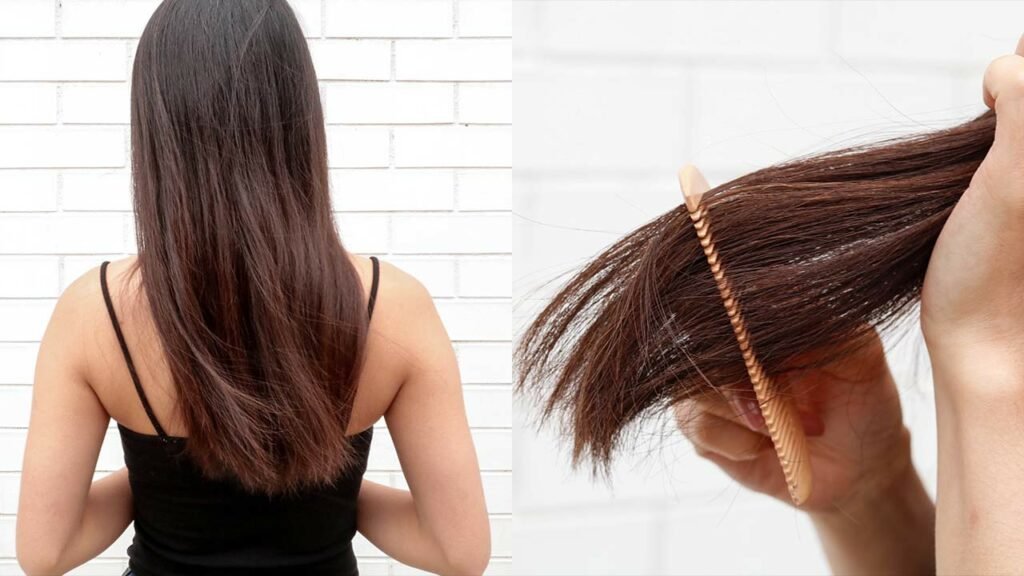Split ends are primarily caused by damage to the hair cuticle, including heat styling, chemical treatments, and lack of moisture. To get rid of split ends, trim your hair regularly, use a deep conditioning treatment, and minimize heat styling.
You can also try using a wide-tooth comb, avoiding tight hairstyles, and protecting your hair from harsh environmental conditions. Additionally, incorporating a healthy diet and using hair products specifically designed for split ends can help improve the condition of your hair.
By following these simple steps, you can effectively reduce and prevent split ends, promoting healthier and more vibrant hair.
Contents
Understanding Split Ends
What Are Split Ends?
Split ends refer to the splitting or fraying of the hair shaft, typically occurring at the ends of the hair. They are also known as trichoptilosis and occur when the protective outer layer of the hair cuticle is damaged or worn away.
Definition
Split ends occur when the hair shaft becomes damaged, resulting in the splitting or fraying of the hair fiber. This can lead to a rough and unhealthy appearance of the hair, making it look dull and frizzy.
Causes
Split ends can be caused by a variety of factors, including:
- Heat damage: Excessive use of hot styling tools can weaken the hair and contribute to split ends.
- Chemical processing: Hair treatments such as bleaching, coloring, and perming can weaken the hair shaft, leading to split ends.
- Environmental factors: Exposure to sun, wind, and pollution can damage the hair cuticle, causing split ends.
- Over-washing and brushing: Excessive washing and brushing can strip the hair of its natural oils and lead to breakage and split ends.
Understanding the causes of split ends is crucial for implementing effective strategies to prevent and treat them.

Common Causes Of Split Ends
Split ends are a common hair concern that can be bothersome for many. It’s important to understand the underlying causes of split ends in order to effectively address and prevent them. By recognizing the common causes, you can make informed decisions to protect your hair and maintain its health. In this section, we will delve into some of the most prevalent reasons behind split ends and provide actionable tips to mitigate their occurrence.
Overstyling And Heat Damage
Overstyling and excessive use of heat styling tools such as flat irons, curling irons, blow dryers, and hot rollers can lead to the formation of split ends. The high temperatures from these tools weaken the hair shaft, stripping it of its natural moisture and causing it to become brittle and prone to splitting. Additionally, frequent and vigorous brushing or combing of the hair can exacerbate the problem by causing friction and mechanical damage to the strands.
Lack Of Proper Hair Care Routine
Neglecting to implement a proper hair care routine can significantly contribute to the development of split ends. Failing to regularly trim the hair to remove damaged ends, skipping moisturizing treatments, and using harsh hair products can all be detrimental to the health of your hair, leading to dryness and breakage.
Environmental Factors
The environment can have a significant impact on the condition of our hair, and environmental factors play a crucial role in causing split ends. Many external elements such as sun exposure, wind, and pollution contribute to the weakening of hair strands, leading to the formation of split ends. Understanding how these factors affect our hair can help us take effective measures to prevent and manage split ends.
Sun Exposure
Prolonged exposure to the sun’s harmful UV rays can damage the outer layer of the hair, making it vulnerable to split ends. The ultraviolet radiation can cause protein degradation in the hair shaft, leading to weakened and brittle strands. To protect your hair from sun damage, consider wearing a hat or using hair products containing UV filters when spending extended periods outdoors.
Wind And Pollution
Wind can roughen the hair cuticle, making it easier for split ends to form. Additionally, pollutants in the air can deposit on the hair, causing dryness and damage. Shielding your hair with a scarf or using protective hairstyles can help minimize the impact of wind and pollution on your hair. Regularly washing and conditioning your hair can also help remove impurities and maintain its health.
Preventive Measures To Avoid Split Ends
Preventing split ends is essential for maintaining healthy hair. By adopting the right habits and implementing regular care, you can effectively minimize the occurrence of split ends. Let’s explore some preventive measures that can help you avoid split ends and maintain the luster of your hair.
Regular Trims
Scheduling regular trims is crucial in preventing split ends. Trimming your hair every six to eight weeks helps to remove the damaged ends, preventing the splits from traveling up the hair shaft. This practice promotes healthier growth and minimizes the risk of split ends.
Proper Conditioning And Moisturizing
Proper conditioning and moisturizing play a key role in preventing split ends. Using a hydrating conditioner after each wash can restore moisture to the hair and reduce the likelihood of breakage. Additionally, applying a nourishing hair mask once a week can provide deep conditioning to the strands, improving their strength and resilience.
10 Effective Ways To Get Rid Of Split Ends
Split ends occur when the hair shaft splits into two or more fragments, and if left untreated, they can lead to further damage and breakage. While it’s not possible to fully repair split ends, there are ways to minimize their appearance and prevent further damage. Here are 10 effective ways to get rid of split ends:
1. Regular Trims: Trim your hair every 6-8 weeks to remove split ends and prevent them from traveling up the hair shaft.
2. Use Sharp Scissors: When trimming your hair, use sharp, professional scissors to ensure a clean cut and prevent additional damage.
3. Avoid Heat Styling: Minimize the use of hot styling tools such as flat irons, curling irons, and blow dryers. When using them, apply a heat protectant spray to reduce damage.
4. Gentle Towel Drying: Pat your hair dry with a soft towel instead of rubbing vigorously to prevent breakage and minimize stress on the hair shaft.
5. Protective Hairstyles: Wear protective hairstyles like braids or buns to reduce exposure to environmental elements that can cause damage.
6. Moisturize Regularly: Use a deep conditioning treatment or hair mask once a week to keep your hair moisturized and prevent dryness, which can lead to split ends.
7. Avoid Harsh Chemicals: Limit the use of harsh chemical treatments such as bleach, perms, and excessive coloring, as these can weaken the hair and contribute to split ends.
8. Silk Pillowcases: Sleep on a silk or satin pillowcase to reduce friction and prevent hair breakage caused by cotton pillowcases.
9. Healthy Diet: Eat a balanced diet rich in vitamins, minerals, and protein to promote overall hair health. Adequate nutrition contributes to stronger hair and reduces the likelihood of split ends.
10. Hydrate from Within: Stay hydrated by drinking enough water. Hydration is essential for maintaining the moisture balance in your hair and preventing dryness and breakage.
Conclusion
In closing, understanding the causes of split ends empowers you to take control of your hair’s health. By adopting simple yet effective practices and making use of nourishing treatments, you can bid farewell to split ends and welcome shiny, healthy locks.
Remember, consistency is key in preventing and treating split ends. Embrace these easy solutions and enjoy the results.

